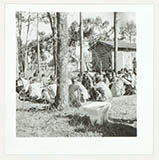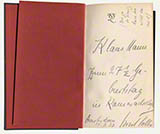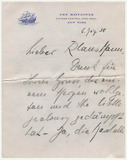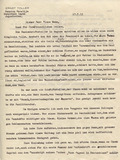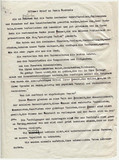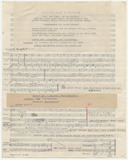Ernst May: Photograph of a POW camp during the Mau Mau uprising in Kenya (c. 1953)
Yearning for GermanyThe small photo shows a disturbing scene. Kenyans crowded behind barbed wire.
Ernst May: Villa project for the third Aga Khan, photograph of model (1951-52)
The architect Ernst May, who had emigrated from Germany, worked for one of the most important men in the African continent for a number of years. May created a girls' school and a maternity clinic for the third Aga Khan and his foundation.
Ernst Toch: Letter to Prince Hubertus zu Loewenstein (7 February 1939)
After stints in Paris, London and New York, the composer Ernst Toch, who had gone into exile in 1933, and settled in Los Angeles in 1936. There he hoped to establish himself as a film composer.
Ernst Toller: Eine Jugend in Deutschland, first edition (1933)
In the first months of exile, which he spent in the house of the writer Emil Ludwig, Ernst Toller finished his autobiography Eine Jugend in Deutschland. He had worked on the manuscript with interruptions since 1929.
Ernst Toller: Letter to Klaus Mann, 6 March 1938
Ernst Toller’s letter to Klaus Mann from 6 March 1938 comes from the time of his return from California to the American east coast. In Hollywood, in February 1937, Toller had signed a lucrative year-long contract as a scriptwriter with MGM Studios.
Ernst Toller: Letter to Klaus Mann, Dubrovnik, 17 July 1933
On 28 May 1933, eighteen days after the book burnings in Germany, the annual congress of the international PEN Club took place in the Yugoslav town of Dubrovnik (Ragusa). The German PEN members had at this time already been “cleansed”, in the Nazi sense, of Jewish and politically unwelcome writers.
Ernst Toller: Open Letter to Joseph Goebbels, Manuscript (1933)
Ernst Toller’s text, Open Letter to Joseph Goebbels, which was produced under the impression of the book burnings of 10 May 1933, appeared at the end of July 1933 in the Braunbuch über Reichstagsbrand und Hitlerterror [Brown Book about the Reichstag Fire and the Hitler Terror].
Erwin Piscator: Letter to Bertolt Brecht (spring 1949)
The whole caboodle or literally “china shop” with a roof spanning two continents mentioned by Erwin Piscator in this letter to the writer Bertolt Brecht is his life after the end of the Second World War.
Erwin Piscator: War and Peace – after the novel by Leo N. Tolstoy, adapted by Erwin Piscator, score by Boris Blacher (1955)
Erwin Piscator had harboured the desire to put on Leo Tolstoy's War and Peace as a stage production for years. The director had become a pacifist and first engaged with the novel as a soldier in World War I.
Eva Herrmann: Bertolt Brecht caricature (circa 1937)
The portrait of Bertolt Brecht is probably part of a collection of around 30 different sketches and preliminary studies that Eva Herrmann made of the poet. The sketches show a drawing technique in which the artist used her preliminary studies to draw the core of what she would later depict in one of her caricatures.
